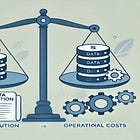In the corporate world, understanding the Data Solution Profit (DSP) is crucial. In our first newsletter, we discussed the importance of knowing the DSP. Today, we will explore how to calculate it and the factors that impact it, including some subtle ones often overlooked.
Starting from the definition of last time
Data Solution Profit = Data Solution Value – Data Solution Costs
Calculating the Data Solution Value
Going a bit deeper, the Data Solution Value can be increased in two ways. The formula is now:
Data Solution Profit = (New Value Generated + Reduced Costs) – Data Solution Costs
Let’s see the two cases:
1. New Value Generated
There are various ways a data solution can create value for a business. Here are a few examples:
Improving decision making: it is the case when thanks to our solution we provide new or better data points to drive business decisions. For example to identify the phase in the customer journey with the highest dropout rate and addressing it.
Enhancing customer experience: it is the case when we offer better metrics to content creators to improve follower engagement.
Enabling new revenue streams: it is the case when our data solution supports senior managers in choosing the best international markets to enter.
Calculating the value created is difficult and it depends on many factors, such as company size and the type of benefit provided. For example, opening a new market is generally more valuable for a large company than a small one. Reducing churn has a different value compared to improving engagement metrics.
So the key message here is try to calculate the value that your solution creates. Then study which is the best way to calculate it. The calculation might be not precise. But at least you have an high level idea of the benefits of your solution and the value you create.
2. Reduced Costs
Cost reduction can also be achieved in various ways:
Automating processes: the most common way to reduce costs is to automate processes. This cost reduction is typically calculated in Full Time Equivalent (FTE) days saved over a specific period, multiplied by the cost of the manual work now automated.
Automation Business Value = FTE days saved by automation x cost of work
While the time saved is a straightforward calculation, consider that the people whose tasks are automated won’t be fired, luckily :), but they can now focus on higher-value activities. Estimating gains from these new activities can be challenging, so it’s often best to simply count only the time saved.
Just an example of the challenge of calculating these gains you might need to ask yourself: “is it a bigger value if the employee time is now spent on better risk management or on upskilling?”. I do not know the answer. Maybe you know but again is not simple.
Reducing risks: lowering risks often translates to cost savings in managing those risks. However, calculating these savings can be complex and varies by case. I will not go much in details here because I do not have the needed experience to tell you more :)
Factors Impacting Data Solution Profit
Whether reducing costs or increasing the generated value, several factors can influence the Data Solution Profit. The most obvious are:
Number of users: generally, a solution used by more users has a higher impact. e.g. Automating a process for 10 users is usually more valuable than for 2.
Value created by each user: solutions aiding employees with higher impact will likely create greater value.
e.g. Helping a sales teams working on large contracts will generally have more impact than helping a team responsible for small contracts.
Also freeing up senior managers' time is for a company more valuable than doing the same for the intern that joined the same team.
There are other subtle factors to consider too.
Increased Adoption: just imagine, you are a Business Intelligence (BI) developer and in you area there is no usage of BI tools at all. You start and users ask you to build only dashboards that look like fancy excel files with big tables and some filters.
Not many people want to use those reports at beginning because they are comfortable with their Excel files. But in the moment you deploy the first 2-3 reports, users start understanding the value and dashboards are step by step accepted. Now many users came to ask if you can do something for them too.In the end you created more value to the company, not with a single report but increasing the adoption of a technology that improve efficiencies.
Strategic Importance: working on projects aligned with the company's strategic goals inherently increases the value of your solution.
Let’s work again with one example, for your company it might be more important to open a new market than increase the presence in the current one. If this is the case, helping increasing the presence in the current market is useful but less important.
Summary
To increase the value of our data solutions, we can either increase the value generated or reduce costs. For both the cases there are other factors to take into account to calculate the value generated: the number and the impact of users, the increase of a technology/process adoption and the strategic importance of the area I’m impacting.
Considering now also the factors the DSP formula looks like this
Data Solution Profit = (New value generated + Cost reduced)*Impacting factors – Data Solution Costs
That’s all for today. In the next newsletter, we will delve into calculating the costs of a data solution.
If you missed, here the first part:
And here the next chapters:
If you enjoyed this newsletter and haven’t subscribed yet, it might be a good idea to
Do you see any other factors that impact the value generated by a business solution? Let me know!
To the next one,
Francesco
Do you want to give a feedback about Better at Data? 📝Do it here




